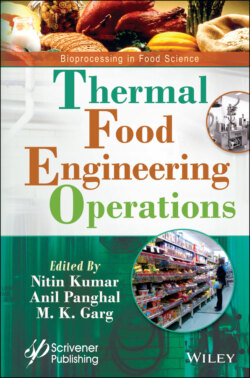Читать книгу Thermal Food Engineering Operations - NITIN KUMAR - Страница 13
1.1 Introduction
ОглавлениеThe primary goal for food processors is quality and safety assurance. To ensure microbiological food safety, the use of heat by thermal operation involving drying, sterilization, evaporation, and other methods are common practices. The conventional heating methods rely on principles such as convection, radiation, and conduction [36] that primarily rely on heat generation exterior of the product to be warmed up. But there are limitations attached to it. These conventional ways of processing, due to the decrease in efficiency of heat transfer, by excessive heating because of time reach the thermal center of foods for conducting sufficient heat or losses because of the heat on the surface of equipment and installation. Some of these problems can be resolved by technical solutions such as heat recycling or advanced designing and installation methods but at high expense.
Therefore research has been made for raising the quality and safety and economic aspects of food through technological development. The novel thermal technologies in which the main processing factor is temperature change as the main parameter responsible for food processing can be considered as the promising alternative in food processing as compared to the traditional process. Unlike traditional technologies, novel thermal technologies are based on electromagnet field (EMI) or electric conductivity. Novel thermal technologies are based on the heat generations directly inside the food. The novel thermal technologies have successfully helped in enhancing the effectiveness of heat processing along with ensuring food safety and maintaining nutritional food properties. Infrared heating has also evolved for the processing of food. The thermal technologies involve the equipment plotted to heat the food to process it, whereas in non-thermal techniques the food is virtually processed without the involvement of food. The general definition of common technologies involved in novel thermal techniques and their basic differences are discussed below.
Ohmic heating is also called Joule heating, electrical residence heating. It is a method of heating the food by the passage of an electric current, so heat is generated due to the electrical current. It is a direct method, as the heat energy is directly dissipated into the food. It is primarily used to preserve food. Electric energy is dissipated into heat, which results in quick and uniform heating followed by maintaining the nutritional value and color. The key variable in electrical conductivity is designing of an effective ohmic meter. Ohmic heating uses a normal electrical supply frequency which is of 50-60Hz. Ohmic heating instantly penetrates directly into the food. The applications of ohmic heating include UHT sterilization, pasteurization, and others.
Dielectric heating is another novel process that provides volumetric heating, for uniform sterilization or preserving of food. It is also a direct method and is based on the process of heating the material by causing dielectric motion in its molecule using alternating electric fields, microwave electromagnetic radiation, or radio wave. The intensity of the electric field and the dielectric properties of the product regulate the volumetric power and absorption and the rate of heat generation. Both microwave heating and radiofrequency belong to this category and follow the principle of dielectric heating. The depth of penetration is directly related to frequency in the case of dielectric heating. The thermal conductivity is not so important in dielectric heating. The few application of microwave and radiofrequency are in freeze-drying, baking, sterilization, rendering, frying, and many others.
Infrared heating is mainly utilized to modify the eating characteristics of food by varying its color, texture, flavor, and odor. Radiant heat is less managed and has a broader range of frequencies. The thermal conductivity is a limiting factor in infrared heating. It acts as an indirect method of heating. Infrared is simply absorbed and converted into heat. It has limited penetration depth in food. It has several advantages over conventional methods such as decreased heating time, reduce quality loss, and uniform heating, versatility, easy to operate and compact equipment, and many others. It also has a vast area of application includes drying, frying, baking, cooking, freeze-drying, pasteurization, sterilization, blanching, and many others.
The other technique is non-thermal heating technologies which are based on pulsed light, pulsed electric fields, ultrasound, and gamma radiation, and others, where the temperature may change also but is not the prime parameter for food processing. The purpose of this chapter is to deliver a general outlook of novel thermal technologies in the food processing sector along with their environmental impact, current trends, and future perspective.
